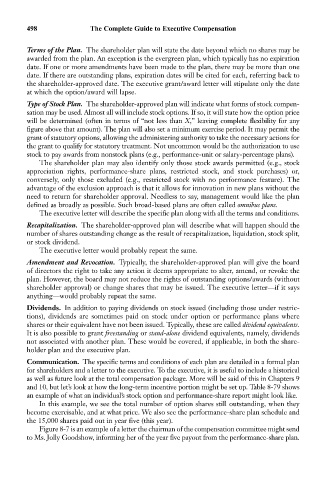Page 512 - Bruce Ellig - The Complete Guide to Executive Compensation (2007)
P. 512
498 The Complete Guide to Executive Compensation
Terms of the Plan. The shareholder plan will state the date beyond which no shares may be
awarded from the plan. An exception is the evergreen plan, which typically has no expiration
date. If one or more amendments have been made to the plan, there may be more than one
date. If there are outstanding plans, expiration dates will be cited for each, referring back to
the shareholder-approved date. The executive grant/award letter will stipulate only the date
at which the option/award will lapse.
Type of Stock Plan. The shareholder-approved plan will indicate what forms of stock compen-
sation may be used. Almost all will include stock options. If so, it will state how the option price
will be determined (often in terms of “not less than X,” leaving complete flexibility for any
figure above that amount). The plan will also set a minimum exercise period. It may permit the
grant of statutory options, allowing the administering authority to take the necessary actions for
the grant to qualify for statutory treatment. Not uncommon would be the authorization to use
stock to pay awards from nonstock plans (e.g., performance-unit or salary-percentage plans).
The shareholder plan may also identify only those stock awards permitted (e.g., stock
appreciation rights, performance-share plans, restricted stock, and stock purchases) or,
conversely, only those excluded (e.g., restricted stock with no performance feature). The
advantage of the exclusion approach is that it allows for innovation in new plans without the
need to return for shareholder approval. Needless to say, management would like the plan
defined as broadly as possible. Such broad-based plans are often called omnibus plans.
The executive letter will describe the specific plan along with all the terms and conditions.
Recapitalization. The shareholder-approved plan will describe what will happen should the
number of shares outstanding change as the result of recapitalization, liquidation, stock split,
or stock dividend.
The executive letter would probably repeat the same.
Amendment and Revocation. Typically, the shareholder-approved plan will give the board
of directors the right to take any action it deems appropriate to alter, amend, or revoke the
plan. However, the board may not reduce the rights of outstanding options/awards (without
shareholder approval) or change shares that may be issued. The executive letter—if it says
anything—would probably repeat the same.
Dividends. In addition to paying dividends on stock issued (including those under restric-
tions), dividends are sometimes paid on stock under option or performance plans where
shares or their equivalent have not been issued. Typically, these are called dividend equivalents.
It is also possible to grant freestanding or stand-alone dividend equivalents, namely, dividends
not associated with another plan. These would be covered, if applicable, in both the share-
holder plan and the executive plan.
Communication. The specific terms and conditions of each plan are detailed in a formal plan
for shareholders and a letter to the executive. To the executive, it is useful to include a historical
as well as future look at the total compensation package. More will be said of this in Chapters 9
and 10, but let’s look at how the long-term incentive portion might be set up. Table 8-79 shows
an example of what an individual’s stock option and performance-share report might look like.
In this example, we see the total number of option shares still outstanding, when they
become exercisable, and at what price. We also see the performance-share plan schedule and
the 15,000 shares paid out in year five (this year).
Figure 8-7 is an example of a letter the chairman of the compensation committee might send
to Ms. Jolly Goodshow, informing her of the year five payout from the performance-share plan.

